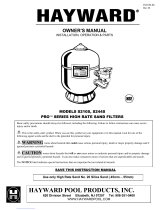
Page 4 of 8 MODEL S180T, S180T90 IS180T90 Rev C
WWW.HAYWARDPOOL.COM USE ONLY HAYWARD GENUINE REPLACEMENT PARTS
INSTALLATION
Only simple tools (screwdriver and wrenches), plus pipe
sealant for plastic adapters, are required to install and/or
service the filter.
1. The filter system should be installed, not more than 6 feet
above pool water level, on a level concrete slab, very firm
ground, or equivalent, as recommended by your pool
dealer. Position the filter so that the piping connections,
control valve and winter drain are convenient and
accessible for operation, service and winterizing.
2. Assemble pump and pump mounting base, to the filter
according to instructions packed with the base.
3. Loading sand media. Filter sand media is loaded through
the top opening of the filter.
a. Loosen flange clamp and remove Filter Control Valve (if
previously installed).
b. Cap internal pipe with sand shield to prevent sand from
entering it. Be sure pipe is securely in place in bottom
underdrain hub.
c. We recommend filling tank approximately 1/2 way with
water to provide a cushioning effect when the filter sand
is poured in. This helps protect the underdrain laterals
from excessive shock. (Be sure the winter drain cap is
securely in place on drain pipe).
NOTE: Check to confirm all laterals are in the
down position before loading with sand. (See
Figure A.)
d. Carefully pour in correct amount and grade of filter
sand, as specified. (Be sure center pipe remains
centered in opening). Sand surface should be leveled
and should come to within 6" of the top of the filter tank.
Remove sand shield from internal pipe.
4. Assemble Filter Control Valve to filter tank.
a. Loosely pre-assemble both halves of the clamp with one
screw and one nut, turning the nut 2 or 3 turns. Do not
tighten. Wipe filter flange clean.
b. Insert Filter Control Valve (with valve/flange O-ring in
place) into the tank neck, taking care that the center pipe
slips into the hole in the bottom of the valve. Install clamp
around tank and valve flange and assemble second screw
and nut. Tighten just enough so that the valve may be
rotated on tank for final positioning.
c. Carefully screw pressure gauge, with pipe tape, into
1/4"NPT tapped hole in valve body. Do not over tighten.
d. Wrap two turns of Teflon pipe sealant tape manufactured
for plastic pipe, on the Straight adapter (12 on Fig B) and
the Elbow adapter (11), starting in the clockwise
direction at the first full thread with a half width overlap
for the full effective thread length.
e. Carefully start the threaded Straight adapter (12) into the
pump (16) discharge (Top Port) and hand tighten.
Further tightening may not be needed to make a leak-
proof joint. However, never tighten more than ½ to 1 ½
turns past hand tight to avoid failure due to over
tightening the joint.
f. Carefully start the threaded Elbow adapter (11) into the
Control Valve (1) port marked PUMP and hand tighten.
Further tightening may not be needed to make a leak-
proof joint. However, never tighten more than ½ to 1 ½
turns past hand tight to avoid failure due to over
tightening the joint.
g. Place two hose clamps (14) over clear hose (13). Fit
hose over straight and elbow adapters and secure with
the clamps. (HINT: If it is difficult to fit hose over
adapters, place hose in hot water for several minutes.
Be Careful HOT WATER can burn you). After the hose
connections are made, tighten valve flange clamp with
screwdriver, tapping around clamp with screwdriver
handle to help seat valve flange clamp. Please be sure
to place the vinyl protector caps over the ends of the
screws.
5. Make return to pool pipe connection to control valve
opening marked RETURN and complete other necessary
plumbing connections, suction lines to pump, waste, etc.
6. Make electrical connections to pump per Pump Owners
Guide instructions.
7. To prevent water leakage, be sure winter drain cap is
securely in place and all pipe connections are tight.
INITIAL START-UP OF FILTER
1. Be sure correct amount of filter sand media is in tank and
that all connections have been made and are secure.
2. Depress Vari-Flo control valve handle and rotate to
BACKWASH* position. (To prevent damage to control valve
seal, always depress handle before turning.)
3. Prime and start pump according to pump instructions (be
sure all suction and return lines are open), allowing the filter
tank to fill with water.
WARNING: ALL SUCTION AND
DISCHARGE VALVES MUST BE
OPEN WHEN STARTING THE
SYSTEM. FAILURE TO DO SO
COULD CAUSE SEVERE PERSONAL
INJURY.
Once water flow is steady out the waste line, run the pump for
at least 2 minutes. The initial back-washing of the filter is
recommended to remove any impurities or fine sand particles
in the sand media.
4. Turn pump off and set valve to RINSE position. Start pump
and operate until water in sight glass is clear—about 1/2 to 1
minute. Turn pump off, set valve to FILTER position and
restart pump. Your filter is now operating in the normal filter
mode, filtering particles from the pool water.
5. Adjust pool suction and return valves to achieve desired
flow. Check system and filter for water leaks and tighten
connections, bolts, nuts, as required.
6. Note the initial pressure gauge reading when the filter is
clean. (It will vary from pool to pool depending upon the
pump and general piping system). As the filter removes dirt
and impurities from the pool water, the accumulation in the
filter will cause the pressure to rise and flow to diminish.
When the pressure gauge reading is 8-10 PSI (0.55-0.69
BAR) higher than the initial "clean" pressure you noted, it is
time to backwash (clean) the filter (see BACKWASH under
Filter Control Valve Functions.)
NOTE: During initial clean-up of the pool water it
may be necessary to backwash frequently due to the
unusually heavy initial dirt load in the water.









